
How to Use GSM SIM900A: Examples, Pinouts, and Specs
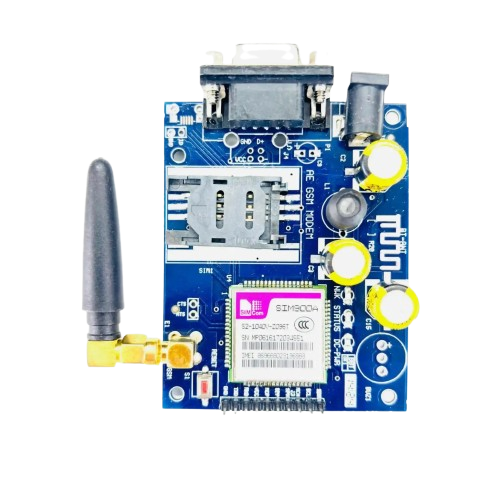
 Design with GSM SIM900A in Cirkit Designer
Design with GSM SIM900A in Cirkit DesignerIntroduction
The GSM SIM900A is a compact and reliable GSM/GPRS module designed for communication over mobile networks. It supports dual-band GSM (900/1800 MHz) and provides functionalities such as sending and receiving SMS, making voice calls, and accessing the internet via GPRS. The module is widely used in IoT applications, remote monitoring systems, home automation, and vehicle tracking systems due to its versatility and ease of integration.
Explore Projects Built with GSM SIM900A
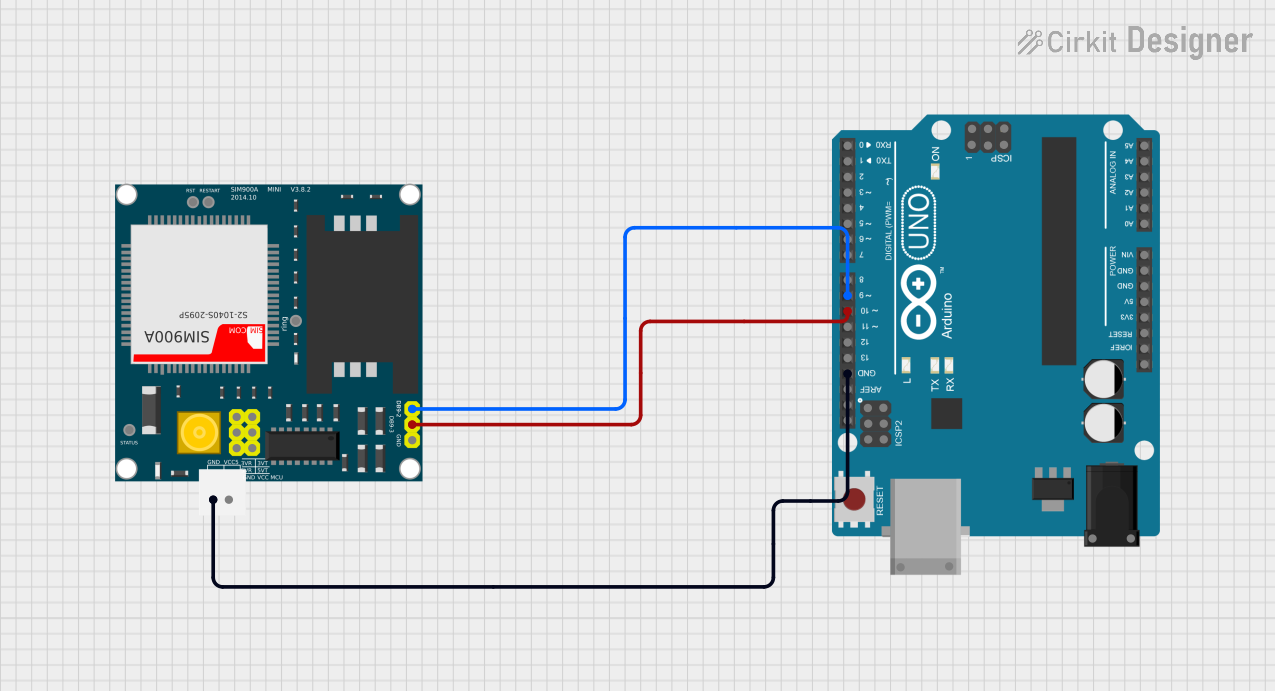
 Open Project in Cirkit Designer
Open Project in Cirkit Designer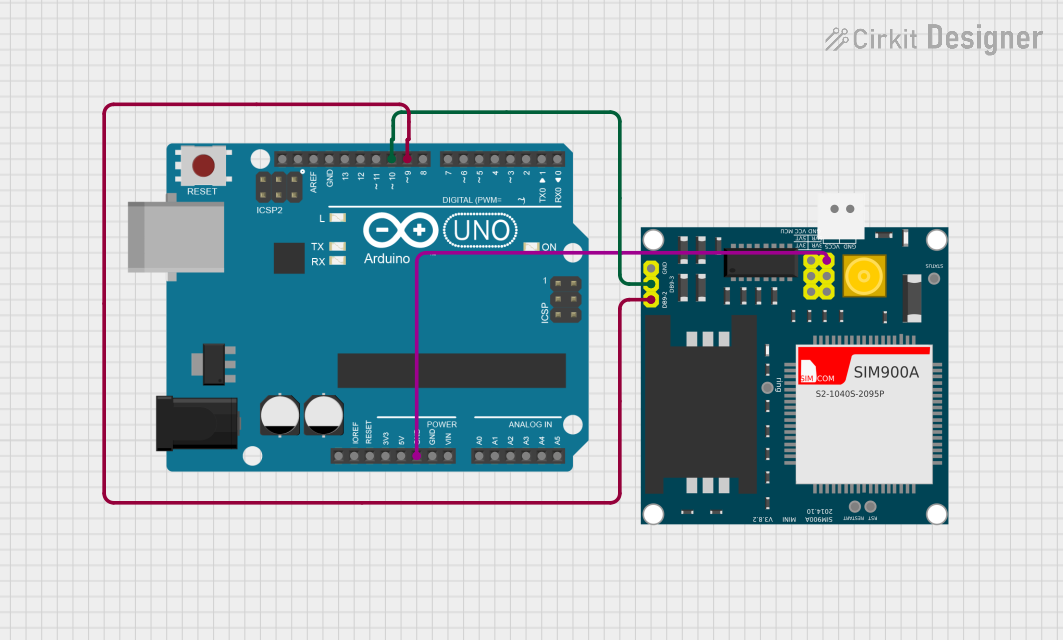
 Open Project in Cirkit Designer
Open Project in Cirkit Designer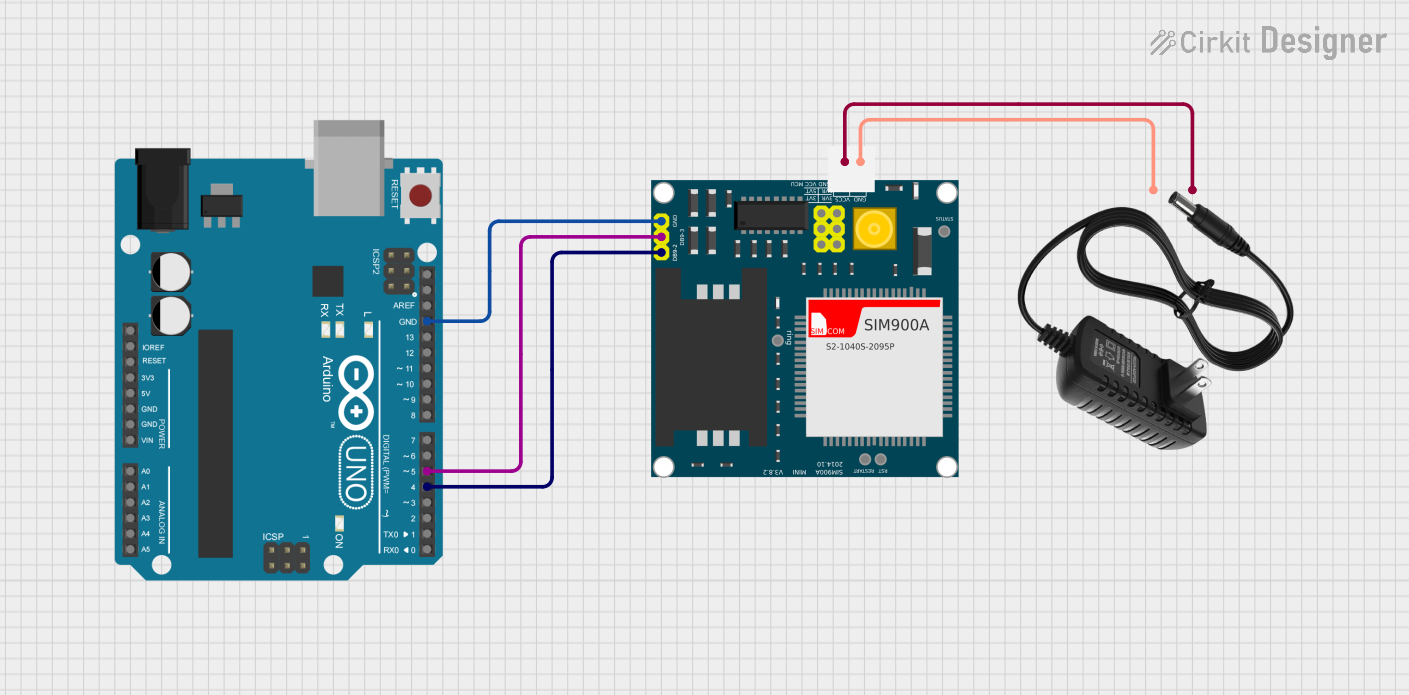
 Open Project in Cirkit Designer
Open Project in Cirkit Designer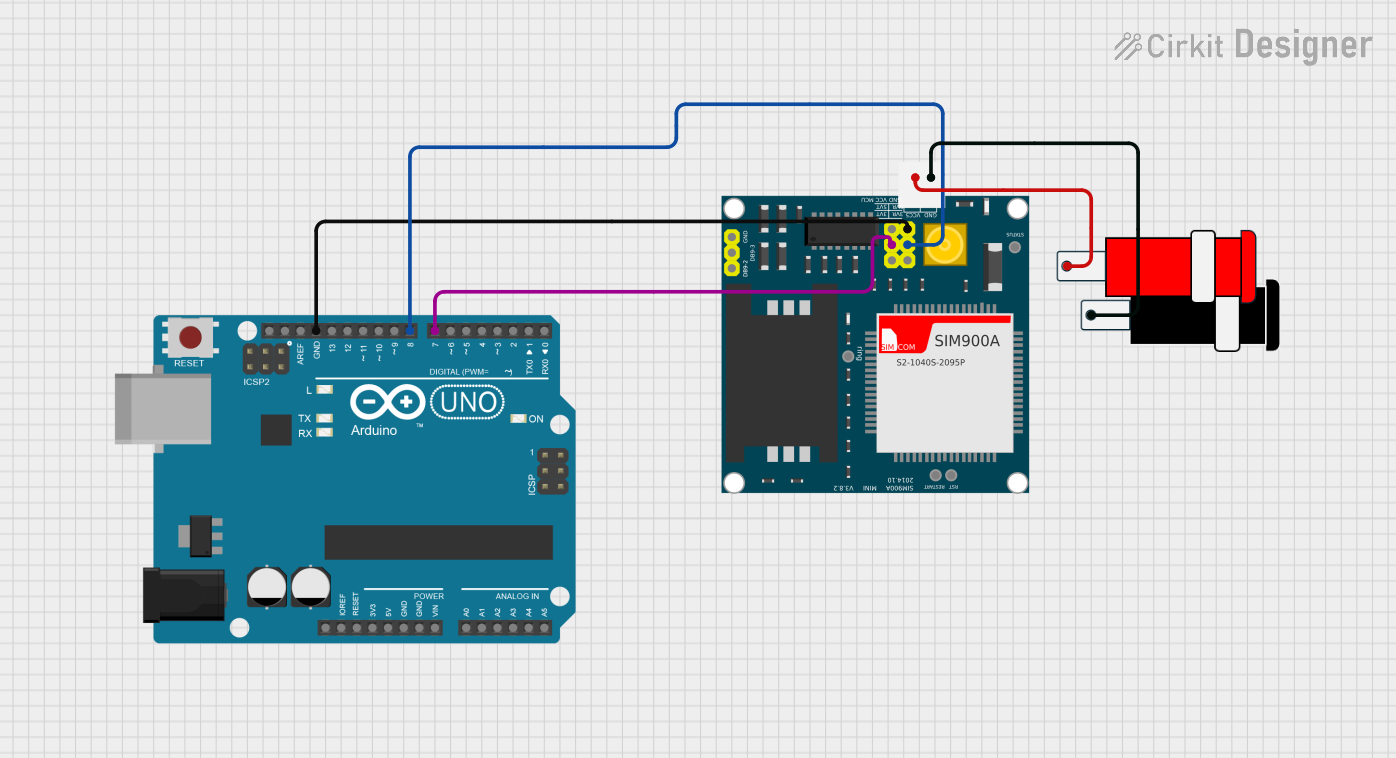
 Open Project in Cirkit Designer
Open Project in Cirkit DesignerExplore Projects Built with GSM SIM900A

 Open Project in Cirkit Designer
Open Project in Cirkit Designer
 Open Project in Cirkit Designer
Open Project in Cirkit Designer
 Open Project in Cirkit Designer
Open Project in Cirkit Designer
 Open Project in Cirkit Designer
Open Project in Cirkit DesignerCommon Applications and Use Cases
- Internet of Things (IoT) devices for remote communication
- SMS-based alert and notification systems
- Voice call-enabled embedded systems
- GPS tracking and vehicle monitoring
- Home automation and security systems
- Industrial automation and telemetry
Technical Specifications
The GSM SIM900A module is designed to operate efficiently in a variety of environments. Below are its key technical details:
Key Technical Details
| Parameter | Specification |
|---|---|
| Operating Voltage | 3.2V to 4.8V (Typical: 4.0V) |
| Operating Current | Idle: ~20mA, Active: ~200mA, Peak: 2A |
| Frequency Bands | GSM 900/1800 MHz |
| Communication Protocols | GSM, GPRS (Class 10) |
| Data Transmission Rate | Uplink: 85.6 kbps, Downlink: 85.6 kbps |
| SIM Interface | 1.8V/3V SIM card support |
| Operating Temperature | -40°C to +85°C |
| Dimensions | 24mm x 24mm x 3mm |
Pin Configuration and Descriptions
The SIM900A module typically comes with a breakout board for easier integration. Below is the pin configuration:
| Pin Number | Pin Name | Description |
|---|---|---|
| 1 | VCC | Power supply input (3.2V to 4.8V) |
| 2 | GND | Ground connection |
| 3 | TXD | Transmit data (UART output) |
| 4 | RXD | Receive data (UART input) |
| 5 | DTR | Data Terminal Ready (used for sleep mode control) |
| 6 | RST | Reset pin (active low) |
| 7 | MIC+ | Microphone positive input for voice calls |
| 8 | MIC- | Microphone negative input for voice calls |
| 9 | SPK+ | Speaker positive output for voice calls |
| 10 | SPK- | Speaker negative output for voice calls |
| 11 | NETLIGHT | Network status indicator (blinks to show GSM status) |
| 12 | SIM_VDD | SIM card power supply |
| 13 | SIM_DATA | SIM card data line |
| 14 | SIM_CLK | SIM card clock line |
| 15 | SIM_RST | SIM card reset line |
Usage Instructions
The GSM SIM900A module can be easily integrated into a circuit for communication purposes. Below are the steps and best practices for using the module:
How to Use the Component in a Circuit
- Power Supply: Connect the VCC pin to a stable 4.0V power source and GND to ground. Ensure the power supply can handle peak currents of up to 2A.
- UART Communication: Connect the TXD and RXD pins to the UART pins of a microcontroller (e.g., Arduino UNO). Use a logic level converter if the microcontroller operates at 5V logic.
- SIM Card: Insert a valid SIM card into the SIM card slot. Ensure the SIM card is activated and has sufficient balance for SMS, calls, or data usage.
- Antenna: Attach a GSM antenna to the module for better signal reception.
- Initialization: Use AT commands to initialize the module and configure its settings. For example, send
ATto check if the module is responding.
Important Considerations and Best Practices
- Use decoupling capacitors near the power supply pins to stabilize the voltage.
- Ensure the antenna is securely connected to avoid signal issues.
- Avoid placing the module near high-frequency components to reduce interference.
- Use proper heat dissipation techniques if the module operates in high-temperature environments.
Example: Connecting to an Arduino UNO
Below is an example of how to send an SMS using the GSM SIM900A module with an Arduino UNO:
Circuit Connections
- Connect SIM900A TXD to Arduino RX (Pin 0).
- Connect SIM900A RXD to Arduino TX (Pin 1).
- Connect SIM900A VCC to a 4.0V power source and GND to ground.
Arduino Code
#include <SoftwareSerial.h>
// Define RX and TX pins for SoftwareSerial
SoftwareSerial SIM900A(7, 8); // RX = Pin 7, TX = Pin 8
void setup() {
// Initialize serial communication
Serial.begin(9600); // For communication with the PC
SIM900A.begin(9600); // For communication with the SIM900A module
// Wait for the module to initialize
delay(1000);
Serial.println("Initializing SIM900A...");
// Send AT command to check module response
SIM900A.println("AT");
delay(1000);
while (SIM900A.available()) {
Serial.write(SIM900A.read()); // Print module response to Serial Monitor
}
// Send SMS command
SIM900A.println("AT+CMGF=1"); // Set SMS mode to text
delay(1000);
SIM900A.println("AT+CMGS=\"+1234567890\""); // Replace with recipient's phone number
delay(1000);
SIM900A.println("Hello, this is a test SMS from SIM900A!"); // SMS content
delay(1000);
SIM900A.write(26); // Send Ctrl+Z to send the SMS
delay(1000);
Serial.println("SMS sent!");
}
void loop() {
// No actions in the loop
}
Troubleshooting and FAQs
Common Issues and Solutions
Module Not Responding to AT Commands
- Ensure the module is powered correctly and the SIM card is inserted.
- Check the UART connections and baud rate settings.
No Network Signal
- Verify that the antenna is connected securely.
- Check if the SIM card is activated and has network coverage.
SMS Not Sending
- Ensure the SIM card has sufficient balance.
- Verify the recipient's phone number format (e.g., include the country code).
Module Restarts Frequently
- Check if the power supply can handle peak currents of up to 2A.
- Use a capacitor (e.g., 1000µF) near the power pins to stabilize the voltage.
FAQs
Q: Can the SIM900A module be used with 5V microcontrollers?
A: Yes, but you need a logic level converter to interface the 3.3V UART pins with 5V logic.
Q: Does the module support 4G networks?
A: No, the SIM900A only supports GSM (2G) networks.
Q: How can I check the signal strength?
A: Use the AT command AT+CSQ. The module will return a signal strength value.
Q: Can I use the module for internet access?
A: Yes, the SIM900A supports GPRS for basic internet connectivity. Use AT commands to configure GPRS settings.